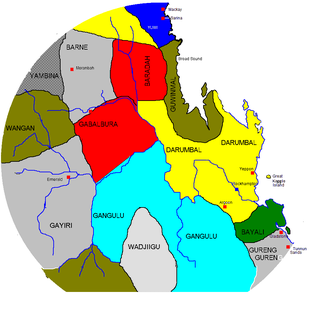The Barungguan are an Aboriginal Australian people of the Cape York Peninsula of Northern Queensland. The name is associated with three languages: Ganganda, Umpithamu and Morrobolam.
The Olkolo or Koko-olkola' are an Indigenous Australian people of central and eastern Cape York Peninsula in northern Queensland. According to Norman Tindale, they are to be distinguished from the Kokangol, higher up on the Alice River watershed.

The Gabulbarra people, also rendered Gabalbura, Gabalbara and Kabalbara, were an Aboriginal Australian people of an area in eastern Central Queensland, but there is little recorded information about them.
The Goeng or Gureng were an Aboriginal Australian people of the state of Queensland. They lived in the area of the area of present-day Gladstone.
The Gunggari, are an Aboriginal Australian tribe of southern Queensland. The traditional land of the Gunggari centres on the Maranoa River and overlaps with the land of the surrounding Mandandanji, Kooma, Kunja, Margany, Dharawala, Bidjara and Nguri peoples. They are to be distinguished from the Kuungkari, who also border Dharawala country.
The Baruŋgam are an Aboriginal Australian people of Southeast Queensland.
The Wanggamala people, also spelt Wangkamahdla, Wangkamadla, Wangkamanha, Wangkamana, Wonkamala, Wongkamala, Wonkamudla, and other variants, are an Aboriginal Australian people of the Northern Territory and Queensland.
The Kambuwal were an indigenous Australian people of the state of Queensland.
The Gugu Rarmul were an indigenous Australian people of the state of Queensland, one of several whose speech was called Gugu Yawa.
The Kokowara were an indigenous Australian people of the state of Queensland.
The Laia were an Aboriginal Australian people of the state of Queensland.
The Wikatinda were an indigenous Australian people of the Cape York Peninsula of northern Queensland. They were one of the Wik peoples, but their language is unattested.
The Yilba, also written Ilba and Jilba, are or were an Aboriginal Australian people of the present-day state of Queensland.
The Iningai (Yiningayi) are an indigenous Australian people of the present-day Longreach Region in the state of Queensland.
The Yanga people, also spelt Jangaa, Janggal, Janga, and Yangaa, are an Aboriginal Australian people of the state of Queensland. They may be the same as the Yukulta / Ganggalida / Nyangga group. They are not to be confused with the Yangga.
The Yagalingu are an Aboriginal Australian people of the state of Queensland. Their language may have been a dialect of Bidjara.
The Kulumali were an indigenous Australian people of the state of Queensland.
The Guŋgañji, also transcribed Gungganyji, Gunggandji, Kongkandji, and other variations, are an Aboriginal Australian people of the state of Queensland.
The Marulta were an indigenous Australian people of the state of Queensland, Australia.
The Kongabula were an indigenous Australian people of the state of Queensland.